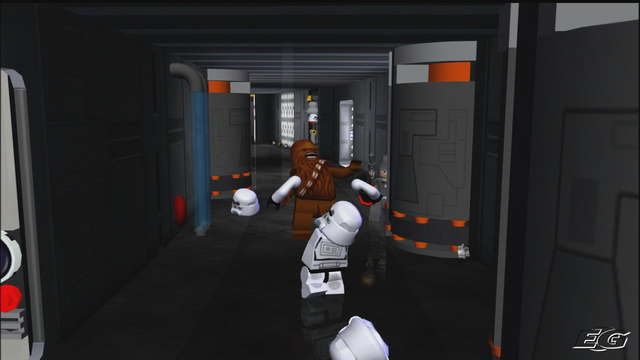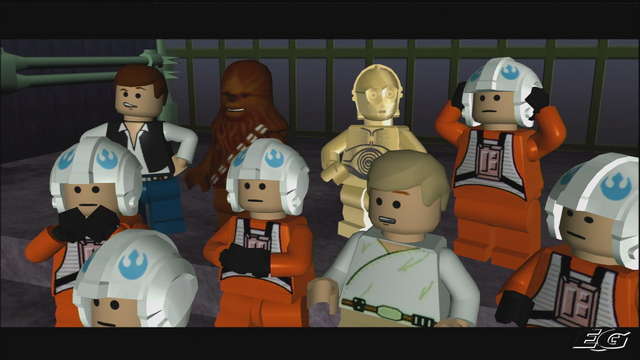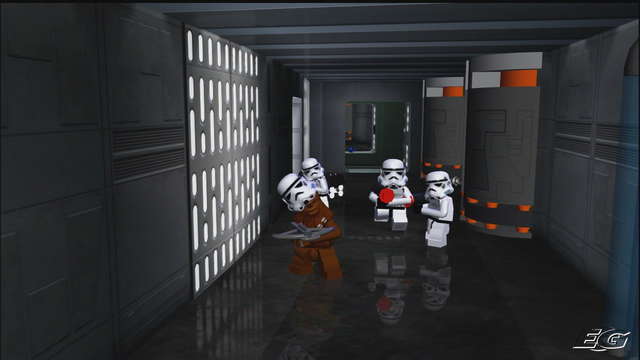Lego Star Wars II: The Original Trilogy
More pure joy in a box.
The trouble with unexpected success is that nobody's surprised when the next thing you do also turns out to be utterly brilliant. Nobody in their right minds expected a Lego Star Wars game to be one of the best kids game ever made. Everyone fully expected dumbed-down fetch quests, patronisingly simplistic dialogue, day-glo visuals, and a one-button control scheme so that little Kevin - aged four-and-a-half - didn't get confused. The sight of this simple, kleptomaniacal, combat-laced platformer belied the fact that here was a game that was nothing short of revelatory in its mass appeal. Full of infectious, warm humour, subtle visual touches and some masterful puzzle design, it was the sort of game that made you want to hug Traveller's Tales for getting it. After so much sorrow had been perpetrated in the name of Star Wars (most of all by Lucas himself) here was an object lesson in how to use a behemoth licence without making gamers feel physically ill. The fact that they managed to make it all hang together isn't so much despite the Lego connection, but because of it, and it was the biggest surprise of 2005.
The fact that the sequel is utterly brilliant, however, is the least surprising fact of 2006.
Removing the earnest cod-seriousness that hangs heavy over any Star Wars interpretation, TT uses the whimsy to its advantage, using Lego as means to make light of the subject matter in the best way possible. It takes full advantage of the inherent nostalgia for Lego to allow us to "walk down two memory lanes at the same time," as self-professed youngling Bramwell pointed out last year. Needless to say, tackling the 'original trilogy' of Episodes IV, V and VI and Lego at the same time is about as potent a mixture as nostalgia gets for a thirty-something. In this case, it's more like striding happily down a memory motorway in an AT-ST, blasting the traffic asunder.
Darth Solo!

Lego Star Wars II kicks off in Mos Eisley Cantina in much the same way that the original put you in Dexter's diner - except you can wander over to a character customisation section and build yourself some crazed mutated abomination using the heads and bodies of familiar names, and settle on your weapon of choice. With that out of the way, you can kick off A New Hope and work your way chronologically through six chapters per 'episode', or clear the first chapter and move onto the other Episodes as you see fit.
Just like the original, the gameplay's the same moreish concoction of combat, puzzling, occasional platforming as well as some flight combat sorties to break things up. You can pretty much guarantee that most levels start off with a quick battle against some Stormtroopers and various Imperial guards, and then require a bitof puzzling in order to open a specific door, or negotiate your party across inaccessible areas before you're forced to get the blaster or lightsaber out again.
As such, the combat's easily the most disappointing element of the Lego Star Wars games, and the sequel hasn't really addressed this in any meaningful sense. Using an over simplified auto aim system, the blaster or bowcaster takes care of almost every enemy in the entire game with one or two shots to the extent that it even takes care of distant targets on overhead gantries. It's certainly a helpful means of making sure kids will enjoy great success, but the drawback is that it makes the lightsaber feel hopelessly clunky and ineffective by comparison. In close combat situations, the Jedi characters can literally squeeze the life out of anyone with their Force Choke move, but it takes far longer to see off a gaggle of enemies all heading for you if you try and swish the lightsaber in their direction than if you simply switch to someone who's handy with a blaster. The melee moves never feel quite right, but any limitations of the design are completely offset by the amount of mindless fun you have in simply smashing up one after the other. Each character has its own specific melee move as well, so it's initially a lot of fun to see Leia slapping enemies indignantly, or Chewy ripping their arms off.
Team leader

Where the gameplay really comes into its own is in its approach to puzzles. At first it might involve little more than rebuilding a pile of loose Lego pieces into, say, a ramp for R2-D2 or the hapless C-3PO to get up, but as the game progresses it becomes an ever more complex, and genuinely hilarious process. In scenes that would make the A-Team's creations seem credible, a random pile of bricks gets transformed (with an excellent flurried animation) into a little truck for someone to ride around in (for no apparent reason), or, more hilariously, a radio or little disco for the natives to rock out to. Later, elaborate, multi-part constructions help you destroy obstacles and rebuild switches, passkey doors, grapple points and anything that the level designers could think of. You can sense they had a lot of fun while making the game, and this knowing nod to the absurdity of what you're doing makes it a real pleasure to chip your way through - if only to see what they can come up with next.
As simple as the game seems to begin with (A New Hope being especially easy), by the time you've reached Return of the Jedi, some of the puzzles are a real test of your resolve. Although the solution is never far away, many times we were stumped because of the simple failure to destroy a seemingly innocuous item first. Our advice: shoot everything. At the very least you'll earn a stack of bolts for it, which you'll quickly realise is vitally important to unlocking the dozens of characters and extras in the game.
Once again, all of the game's 18 main chapters are designed very much as a co-operative experience regardless of whether you're playing it alone or in two-player mode with a pal. At all times you're accompanied by at least one other appropriate cast member (and sometimes five or more trail around after you), and this not only allows a friend to drop in on the action at any time in the game, but mean that you can quickly walk up to any one of the other characters and take control of them. Not only does this help in combat situations (with certain characters lacking weapons of any description), but means you can bypass certain security devices, or take advantage of certain special moves, like R2-D2's ability to hover across otherwise unreachable gaps, or Luke Skywalker's useful double-jump ability. Force powers, in particular, become essential puzzle-solving abilities, with the Jedi's able to haul heavy items (that glow blue to let you know you can move them) to enable you to piece together specific items or destroy obstacles.
De-railed

With no shortage of famous vehicular sequences to draw upon, we get to indulge in a number of superb, fast-paced sequences, such as the landspeeder in the Forest of Endor, or the X-Wing in the Death Star trenches, or the epic final Millennium Falcon destroy/escape sequence in Return of the Jedi. These sections, in particular, are ace, all off the rails to allow you to fly the ships yourself, dragging missiles around with you and launching them with slingshot precision. The control's fluid, responsive and the action's relentlessly exciting, but, man, they're the noisiest levels ever. Be warned!
In addition, many of the 'normal' levels now come with a variety of vehicles to leap in and out of, allowing you to stomp around in the lethal AT-STs, taking out hordes of enemies with your laser cannon and squishing the stragglers. Elsewhere, you can hop into a dewback and chomp anyone who gets in your way, or simply use the banthas to reach inaccessible platforms.
Perhaps the greatest improvement to the already excellent design is the way Lego Star Wars II tempts you back for more with a host of unlockable extras and rewards. Hidden throughout all the main story chapters are numerous collectables that are somewhat off limits to you the first time through. For example, several times you'll encounter areas that inform you that 'only Bounty Hunters can access here', or you'll see a security door that only C-3PO can enter, and this is where freeplay comes in. By giving you the ability to switch characters on the fly, with a flick of the shoulder button you can play as Darth Vader one minute, switch to R2-D2 to open a door, before switching back to someone with grappling abilities. In no time you'll have hoovered up all manner of secret loot, gained 'True Jedi' status, and all the ship parts lying around. Unlike the original, gathering all the mini-kit pieces does more than simply build a ship outside the Cantina. The determined among you will find another two vehicle-based levels per Episode to unlock - extending the game's overall longevity enormously. Given that the three Episodes take over ten hours to polish off on your first run-through, it safe to say that game directors Tom Stone and Jonathan Smith definitely listened to the feedback over the original's length and replayability.
Bad hair day

Needless to say, with character design as intentionally simplified as this, Lego Star Wars II was never going to be a game to test the 360's capabilities to any great extent, but that's not to say the game doesn't look the business. Sure, you're buying into the sharpest, cleanest version of them all (and have 29 tough achievements to unlock if you're into the Gamerscore war), but the visuals get by on the hilarious animation, the stupendous cut-scenes and the delightful attention to detail in every corner of the game. As before, you might get a little riled with the inability to shift the camera angle, but the good far outweighs the bad, and occasionally we get treated to some delightful sequences - check out the Endor forest level, for instance, or some of the space combat sorties. The final level even reminded us of Rez. Which is nice.
And who could fail to fall in love with the character design? No matter how simplified, you always know which one's Han Solo, which one's Princess Leia, and seeing the end sequence where Luke pulls off Darth's helmet is worth the price tag alone. The endless small expressions and non-verbal grunts in the dialogue-free cut-scene are just joyous, and well worth repeat viewing. It's a twisted, comic re-imagining of the Star Wars universe, but in the most respectful way possible. It certainly beats any number of the serious attempts at making a Star Wars game, that's for sure.
Perhaps the only downside about Lego Star Wars II is that the melee combat remains weak throughout, some of the latter puzzles can be wilfully obscure, and that Traveller's Tales neglected to allow co-op to be played online. Apart from that, it's one of the most instantly enjoyable games around, and were it not for the humbling price tag, we'd demand you go out and add it to your collection immediately. Whether you're 3 or 33, this is one of those rare games that can genuinely appeal to everyone whether you're into Star Wars or not.


